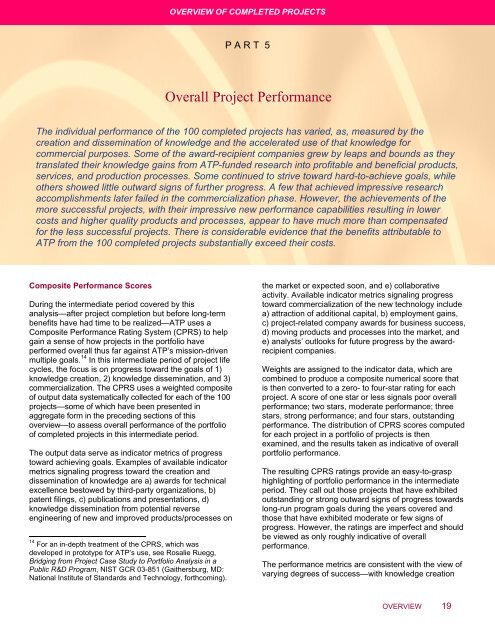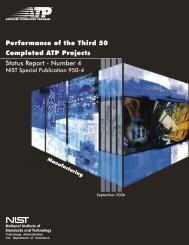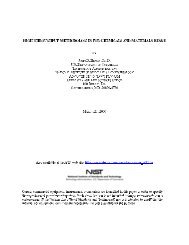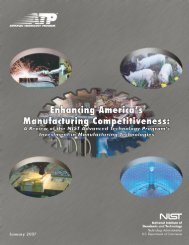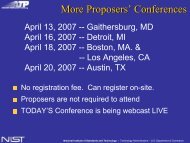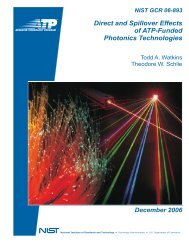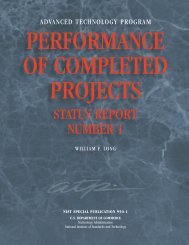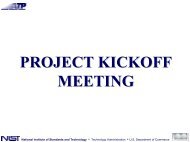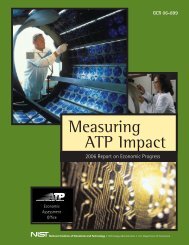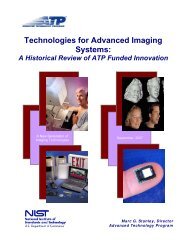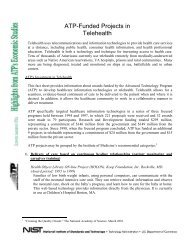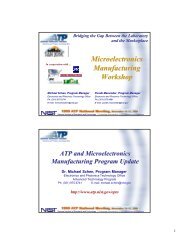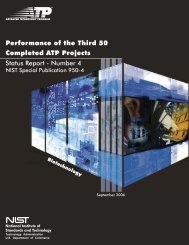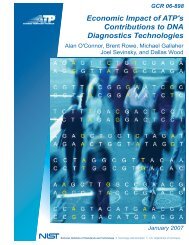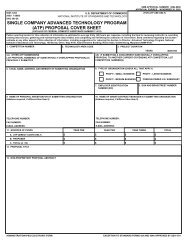Overall Project Performance - NIST Advanced Technology Program ...
Overall Project Performance - NIST Advanced Technology Program ...
Overall Project Performance - NIST Advanced Technology Program ...
You also want an ePaper? Increase the reach of your titles
YUMPU automatically turns print PDFs into web optimized ePapers that Google loves.
OVERVIEW OF COMPLETED PROJECTS<br />
P A R T 5<br />
<strong>Overall</strong> <strong>Project</strong> <strong>Performance</strong><br />
The individual performance of the 100 completed projects has varied, as, measured by the<br />
creation and dissemination of knowledge and the accelerated use of that knowledge for<br />
commercial purposes. Some of the award-recipient companies grew by leaps and bounds as they<br />
translated their knowledge gains from ATP-funded research into profitable and beneficial products,<br />
services, and production processes. Some continued to strive toward hard-to-achieve goals, while<br />
others showed little outward signs of further progress. A few that achieved impressive research<br />
accomplishments later failed in the commercialization phase. However, the achievements of the<br />
more successful projects, with their impressive new performance capabilities resulting in lower<br />
costs and higher quality products and processes, appear to have much more than compensated<br />
for the less successful projects. There is considerable evidence that the benefits attributable to<br />
ATP from the 100 completed projects substantially exceed their costs.<br />
Composite <strong>Performance</strong> Scores<br />
During the intermediate period covered by this<br />
analysis—after project completion but before long-term<br />
benefits have had time to be realized—ATP uses a<br />
Composite <strong>Performance</strong> Rating System (CPRS) to help<br />
gain a sense of how projects in the portfolio have<br />
performed overall thus far against ATP’s mission-driven<br />
multiple goals. 14 In this intermediate period of project life<br />
cycles, the focus is on progress toward the goals of 1)<br />
knowledge creation, 2) knowledge dissemination, and 3)<br />
commercialization. The CPRS uses a weighted composite<br />
of output data systematically collected for each of the 100<br />
projects—some of which have been presented in<br />
aggregate form in the preceding sections of this<br />
overview—to assess overall performance of the portfolio<br />
of completed projects in this intermediate period.<br />
The output data serve as indicator metrics of progress<br />
toward achieving goals. Examples of available indicator<br />
metrics signaling progress toward the creation and<br />
dissemination of knowledge are a) awards for technical<br />
excellence bestowed by third-party organizations, b)<br />
patent filings, c) publications and presentations, d)<br />
knowledge dissemination from potential reverse<br />
engineering of new and improved products/processes on<br />
14 For an in-depth treatment of the CPRS, which was<br />
developed in prototype for ATP’s use, see Rosalie Ruegg,<br />
Bridging from <strong>Project</strong> Case Study to Portfolio Analysis in a<br />
Public R&D <strong>Program</strong>, <strong>NIST</strong> GCR 03-851 (Gaithersburg, MD:<br />
National Institute of Standards and <strong>Technology</strong>, forthcoming).<br />
the market or expected soon, and e) collaborative<br />
activity. Available indicator metrics signaling progress<br />
toward commercialization of the new technology include<br />
a) attraction of additional capital, b) employment gains,<br />
c) project-related company awards for business success,<br />
d) moving products and processes into the market, and<br />
e) analysts’ outlooks for future progress by the awardrecipient<br />
companies.<br />
Weights are assigned to the indicator data, which are<br />
combined to produce a composite numerical score that<br />
is then converted to a zero- to four-star rating for each<br />
project. A score of one star or less signals poor overall<br />
performance; two stars, moderate performance; three<br />
stars, strong performance; and four stars, outstanding<br />
performance. The distribution of CPRS scores computed<br />
for each project in a portfolio of projects is then<br />
examined, and the results taken as indicative of overall<br />
portfolio performance.<br />
The resulting CPRS ratings provide an easy-to-grasp<br />
highlighting of portfolio performance in the intermediate<br />
period. They call out those projects that have exhibited<br />
outstanding or strong outward signs of progress towards<br />
long-run program goals during the years covered and<br />
those that have exhibited moderate or few signs of<br />
progress. However, the ratings are imperfect and should<br />
be viewed as only roughly indicative of overall<br />
performance.<br />
The performance metrics are consistent with the view of<br />
varying degrees of success—with knowledge creation<br />
OVERVIEW 19
and dissemination constituting partial success, and a<br />
continuation into commercialization constituting a fuller<br />
degree of success in terms of project progress. Some<br />
companies carried out their proposed research with a<br />
degree of success during the time of ATP funding, but<br />
then did not continue pursuit of their project’s larger<br />
goals after ATP funding ended. At this stage of<br />
evaluation, ATP considers such projects only partial<br />
successes, because the direct path for achieving project<br />
goals is truncated. Such projects are not among the<br />
higher scorers in this report. It is possible, however, that<br />
developments along the indirect path (diffusion of<br />
knowledge from the project through publications,<br />
presentations, patents, and licensing) may nevertheless<br />
occur—particularly if a project produced effective<br />
knowledge transmitters, such as patents and<br />
publications. It is also possible that a company may work<br />
in secrecy for a long period of time with no visible<br />
outputs and then suddenly explode on the scene with a<br />
single output that will yield large societal benefits.<br />
Nanophase <strong>Technology</strong> Corporation, Cree Research,<br />
Inc., Aastrom Biosciences, Inc., Tissue Engineering,<br />
Inc., ColorLink, Torrent Systems, Inc., American<br />
Superconductor Corporation, and the National Center for<br />
Manufacturing Science.<br />
The next tier of 33 strong projects included 28 singleapplicant<br />
projects and 5 joint-venture projects. Of the<br />
single-applicant projects, 22 were led by small<br />
companies, 2 by medium companies, and 4 by large<br />
companies. Of the joint ventures, two were led by small<br />
companies, one by an industry consortium, one by a<br />
large company, and one by a nonprofit organization.<br />
A few projects with low CPRS ratings had impressive<br />
technical achievements as indicated by the receipt of a<br />
third-party technical award, though most of the technical<br />
awards went to those with the highest overall ratings. In<br />
contrast, all of the awards for business acumen went to<br />
the projects with CPRS ratings of three or four stars.<br />
Limiting factors include the extent to which not all<br />
relevant effects are captured; moreover, the use of<br />
indicator metrics is constrained by data availability, the<br />
development of the weighting system is empirically<br />
driven rather than theoretically based, and the ratings do<br />
not directly measure national benefits. The degree of<br />
correlation between a project’s performance score and<br />
its long-run societal benefits is impossible to know at this<br />
time. <strong>Project</strong>s with the same scores are not necessarily<br />
equal in their potential benefits. They are, however,<br />
somewhat comparable in terms of the robustness of their<br />
progress to date.<br />
Scoring the First 100 Completed <strong>Project</strong>s<br />
The distribution of CPRS scores for ATP’s<br />
first 100 completed projects is shown in<br />
Figure 5.1. The largest group of projects,<br />
33 percent, fell in the three-star category—<br />
showing strong progress. Combining these<br />
with the 12 percent rated “outstanding,”<br />
shows an impressive 45 percent of<br />
projects performing at a high level.<br />
Twenty-seven percent fell into the two-star<br />
category—moderate progress, but not<br />
particularly robust overall. Twenty-eight<br />
percent of the projects scored one star or<br />
less, indicating poor performance overall—<br />
perhaps not surprising for companies<br />
taking on difficult goals.<br />
The 12 top-scoring projects overall include<br />
11 single-applicant projects led by small<br />
companies and 1 joint venture led by a<br />
consortium. Leaders of these top-scoring<br />
projects were Engineering Animation, Inc.,<br />
Integra LifeSciences, Third Wave<br />
Technologies, X-Ray Optical Systems,<br />
<strong>Performance</strong> by <strong>Technology</strong> Areas<br />
<strong>Overall</strong> project performance in the intermediate period<br />
covered by the study varied by technology area, as<br />
illustrated in Figure 5.2. Of the 12 biotechnology<br />
projects, 8 were 3- or 4-star projects. Of the 30<br />
electronics projects, half scored high. Of the 20<br />
manufacturing projects, close to half scored high, but 45<br />
percent scored low. The 19 projects in the materials<br />
group were more evenly divided into high, low, and<br />
moderate scorers. The 19 information technology<br />
projects had 7 projects that were both moderate and<br />
high-scoring projects and 5 low-scoring projects.<br />
Differences in life cycles among the technology areas<br />
may account for part of the performance differences, but<br />
Figure 5.1 Distribution of <strong>Project</strong>s by Star Rating<br />
20 OVERVIEW
Figure 5.2 Distribution of Star Ratings by <strong>Technology</strong> Area<br />
a retrospective study of the Auto Body Consortium’s<br />
dimensional control project. 17 More recently, RTI<br />
conducted an economic study of ATP’s investment in<br />
a portfolio of 24 component-based software projects,<br />
3 of which are among the first 100 completed studies<br />
examined here. 18<br />
The following examples draw on the economic<br />
evaluation studies mentioned above to provide a<br />
rough notion of quantified net benefits. In addition, it<br />
supplements the results of the economic studies with<br />
several examples of projects/companies that also<br />
appear to be generating significant economic benefits.<br />
the relatively small number of projects in each category<br />
does not support the drawing of robust conclusions<br />
about how projects in the different technology areas will<br />
perform.<br />
<strong>Project</strong> <strong>Performance</strong> Translated into Economic and<br />
National Security Benefits<br />
For a few of the 100 projects, in-depth evaluation studies<br />
have been conducted to estimate at least part of their<br />
expected economic impacts. One such study conducted<br />
by economists at the Research Triangle Institute (RTI), a<br />
consulting firm in North Carolina, included three medical<br />
technologies that are among the first 100 completed. 15<br />
RTI economists provided early estimates of the value of<br />
a new biopolymer to repair fractures, developed by<br />
Integra LifeSciences; a system for replicating stem cells,<br />
developed by Aastrom Biosciences, Inc.; 16 and a new<br />
prosthesis material—animal-derived extracellular matrix,<br />
or ADMAT—developed by Tissue Engineering, Inc.<br />
Professor Karen Polenske and Nicolas Rockler from the<br />
Massachusetts Institute of <strong>Technology</strong> (MIT) completed<br />
15 Martin, Sheila A., Daniel L. Winfield, Anne E. Kenyon, John<br />
R. Farris, Mohan V. Bala, and Tayler H. Bingham, A<br />
Framework for Estimating the National Economic Benefits of<br />
ATP Funding of Medical Technologies, <strong>NIST</strong> GCR 97-737<br />
(Gaithersburg, MD: National Institute of Standards and<br />
<strong>Technology</strong>, April 1998).<br />
16 Aastrom Biosciences, Inc. utilized human hematopoetic stem<br />
cells derived from blood or bone marrow for its ATP-supported<br />
research and continues to use bone marrow and umbilical cord<br />
blood in its development efforts. The bone marrow and cord<br />
blood utilized by Aastrom during its research complied with the<br />
regulations for the protection of human subjects as codified by<br />
the Department of Commerce at 15 CFR Part 27.<br />
Biocompatible Polymers for Cartilage Repair: The<br />
RTI study estimated the medical cost savings from<br />
the project led by Integra LifeSciences, in terms of<br />
avoiding second surgeries to remove implants, such<br />
as pins and screws, when trouble arises. Integra has<br />
shown continued robust progress since the RTI study<br />
was completed several years ago. At the time the<br />
project analysis for this mini-study was completed in<br />
late 1999, company employment, which was 32 at<br />
the project’s start, had increased fourfold. A recent<br />
check showed nearly a 24-fold increase in the<br />
company’s employment to 760, in part through internal<br />
growth and in part through acquisitions. The company’s<br />
sales revenue was reported at $118 million in 2002, and<br />
a recent Standard and Poor’s stock report estimated a<br />
44-percent increase in revenue in 2003, pointing to the<br />
company’s participation in an expanding number of<br />
markets. 19 Through its commercial partners, Integra’s<br />
technology is utilized in surgical fixation devices for<br />
attaching soft tissue to bone in the knee and shoulder.<br />
These products are currently in clinical trials. Patient<br />
benefits include avoidance of medical complications and<br />
further surgeries associated with utilizing existing<br />
technologies, as well as lower surgical costs.<br />
Stem Cell Replication: Because of the difficulty of<br />
estimating the value of patient pain reduction and<br />
improved health outcomes, the RTI study also based the<br />
benefits estimates for Aastrom’s stem cell expansion<br />
technology only on the reduction in procedure costs,<br />
although it is the patient pain avoidance and improved<br />
outcome effects that were the main expected benefit of<br />
this technology. By allowing a small amount of stem cells<br />
to be multiplied into a larger quantity, the technology<br />
reduces donor clinic visits to collect the stem cells;<br />
17 Polenske, Karen, and Nicolas Rockler, Closing The<br />
Competitive Gap: An Analysis of the ATP 2mm <strong>Project</strong>,<br />
<strong>NIST</strong> GCR 03-856 (Gaithersburg, MD: National Institute<br />
of Standards and <strong>Technology</strong>, July 2004).<br />
18 White, William J. and Michael P. Gallaher, Benefits and<br />
Costs of ATP Investments in Component-Based Software,<br />
<strong>NIST</strong> GCR 02-834 (Gaithersburg, MD: National Institute of<br />
Standards and <strong>Technology</strong>, November 2002).<br />
19 Standard and Poor’s stock report.<br />
OVERVIEW 21
educes procedure hours; is easier for medical staff to<br />
perform; reduces treatment costs; substantially reduces<br />
patient pain and negative side effects; and has been<br />
shown to result in better treatment outcomes.<br />
RTI economists estimated that once it was implemented,<br />
Aastrom’s replication system (commercialized as the<br />
AastromReplicell System), would save several million<br />
dollars in the costs of providing bone-marrow transplants<br />
for cancer treatment<br />
Aastrom has since continued unabated pursuit of the<br />
commercialization of its AastromReplicell System.<br />
According to a Standard and Poor’s stock report, the<br />
company over time has made a strategic shift in its<br />
business model from that originally centered on the bone<br />
marrow transplantation market, to a model focused on<br />
multiple paths to using human cell-based therapies for<br />
stem cell repair and regeneration, cancer treatments,<br />
and infectious disease treatments. Core to the original<br />
and the new business models is its ability to grow stem<br />
cells outside the body, the ATP-funded technology.<br />
The edition of this report that covered the first 50<br />
completed projects described how a recent clinical trial<br />
had demonstrated success in using the cell replication<br />
system to enable cancer patients—for which there were<br />
otherwise no donors—to receive stem cell transplants by<br />
expanding tiny amounts of cord blood samples that<br />
matched the patients. 20 According to the director of<br />
medical oncology at Hackensack University Medical<br />
Center, “These results suggest that we may have found<br />
a new treatment approach that will enable more patients<br />
to receive treatment for this very serious and often fatal<br />
disease [leukemia].” 21 According to the American Cancer<br />
Society, 2,800 new cases of leukemia will be found in<br />
children in 2005, making new, more effective treatments<br />
of great value to society. 22<br />
An investigation of developments revealed that in<br />
September 2003, Aastrom received a National Institutes<br />
of Health grant—one of several grants—to demonstrate<br />
20 Cord blood, the blood in the umbilical cord and placenta after<br />
the birth of a child, has been found to offer an alternative<br />
source of stem cells for transplantation that provides an<br />
acceptable transplant even with a higher degree of tissue<br />
mismatching. As a result, a cord-blood banking infrastructure is<br />
being established, but the small amount of cells available from<br />
this source restricts its use. In recent clinical studies, several<br />
adult cancer patients needed very high-dose chemotherapy to<br />
be followed by a stem cell transplant, but no suitable bone<br />
marrow donors could be found. In the cord blood bank, small<br />
samples were found that provided a match, but the amounts<br />
were too small to be used. In the clinical trials, the<br />
AastromReplicell System was used to replicate the number<br />
of matching cord blood cells, allowing the patients (for which<br />
there were otherwise no donors) to receive stem cell<br />
transplants.<br />
21 Company press release, April 19, 2000.<br />
22 http://www.cancer.org/docroot/home/index.asp<br />
the feasibility of using the cell replication system for the<br />
production of completed dendritic cell-based vaccines for<br />
immunotherapy against ovarian cancer, the leading<br />
cause of gynecological cancer-related deaths in women.<br />
Recent studies reportedly have shown that dendritic<br />
cells produced and exposed to cancer molecules have<br />
resulted in immune responses. But there are difficulties<br />
in producing the quantities of antigen-loaded dendritic<br />
cells needed to perform a complete immunotherapy<br />
treatment in patients with cancer, which is why the<br />
AastromReplicell System is needed. 23<br />
There have been news releases about the company’s<br />
commercial activities. In activities related to the<br />
immunotherapy approach reported above, the company<br />
is reportedly preparing to begin clinical studies of its<br />
approach in collaboration with Stanford University for<br />
multiple myeloma cancer and with Duke University for<br />
colorectal cancer. 24 Other reports describe an<br />
agreement with Astro Instrumentation, L.L.C. to<br />
manufacture the subassemblies and parts of the<br />
instrumentation platform of the AastromReplicell<br />
System. 25<br />
Biomaterials for Prostheses: RTI predicted expected<br />
benefits from the first application of Tissue Engineering’s<br />
(now TEI Biosciences) ADMAT technology, namely, the<br />
repair of damaged knee ligaments (specifically, anterior<br />
cruciate ligaments, or ACLs). RTI was able to estimate<br />
benefits expected to result from improvements in the<br />
quality of life for patients receiving the treatment by<br />
using a “quality adjusted-life-years” index value. 26 As of<br />
2004, TEI has sales exceeding $2 million from three<br />
products on the market, and has strategic collaborations<br />
with Medtronic, Stryker Orthopedics, and other U.S.<br />
medical device companies. The products are used by<br />
more than 450 surgeons and have benefited more than<br />
1,200 patients.<br />
Auto Body Manufacturing Assembly: One project, led<br />
by the Auto Body Consortium (ABC), has generated<br />
documented production cost savings, has improved<br />
automobile quality, and has demonstrated the potential<br />
for extending these same kinds of benefits to the<br />
manufacturing assembly of other products. A<br />
retrospective study on this project by researchers at MIT<br />
found that the project reduced variation of critical body<br />
dimensions to meet the 2-millimeter objective (with +/-<br />
1mm variance) and was the key driving force in<br />
changing the manufacturing quality control technology<br />
23 CBS MarketWatch, September 15, 2003.<br />
24 Ibid.<br />
25 CBS MarketWatch, August 26, 2003.<br />
26 For a description of the use of Quality Adjusted Life Years<br />
(QALY) in evaluating patient benefits in evaluation studies, see<br />
Andrew Wang, “Key Concepts in Evaluating Outcomes of ATP<br />
Funding of Medical Technologies,” Journal of <strong>Technology</strong><br />
Transfer, Vol. 23 (2), 1998, pp. 61-66.<br />
22 OVERVIEW
used to improve quality, reduce cost, and shorten timeto-market<br />
by domestically owned vehicle manufacturers.<br />
The implementation of 2-millimeter technology helped<br />
domestic producers slow the loss of market share to<br />
offshore and transplant manufacturers, created no fewer<br />
than 1,400 new jobs, and generated, by conservative<br />
estimate, an increase of $186 million in gross domestic<br />
product (measured over a 10-year period following the<br />
start of the ATP-funded project). 27<br />
Component-Based Software (CBS): Developing the<br />
capacity to build large software systems from<br />
assemblies of smaller, reusable, independent<br />
components is an important strategy to reduce software<br />
system costs, increase system reliability, and enable<br />
lower cost upgrades. Three projects included among the<br />
first 100 Status Reports were part of a portfolio of 24<br />
projects that was included in an in-depth economic case<br />
study conducted by RTI. 28 These projects were led by<br />
Reasoning Inc., TopicalNet, Inc. (formerly Continuum<br />
Software), and HyBrithms (formerly Hynomics Corp.).<br />
Across the entire CBS portfolio, RTI’s economic study<br />
estimated $840 million in net-present-value benefits and<br />
a benefit-to-cost ratio at 10.5, suggesting that the<br />
investment in the portfolio of projects as a whole was<br />
worthwhile. The net-benefits estimate is based on the<br />
cost of all 24 projects, but the estimated benefits of only<br />
8 were the subject of the detailed case study. In addition,<br />
the study found other benefits that were presented<br />
qualitatively, namely, enhancing the credibility of the<br />
mostly small software firms that were funded and<br />
assisting firms in strengthening their planning and<br />
management functions.<br />
Reasoning Inc., TopicalNet Inc. (formerly Continuum<br />
Software), and HyBrithms (formerly Hynomics Corp.)<br />
had commercialization activities underway when RTI<br />
conducted its study. Their costs, but not their benefits,<br />
were included in RTI’s aggregate portfolio net-benefit<br />
measure, because they were not among the eight projects<br />
selected by RTI for the portfolio benefits assessment.<br />
Thus, the RTI study results, at best, suggest that the three<br />
projects are part of a portfolio of projects found to be<br />
valuable. Of the three projects, two are rated as three-star<br />
performers, and one is a two-star performer.<br />
It is also informative to look at how some of the other<br />
projects that were rated as top performers have<br />
progressed since the original data were compiled and<br />
the CPRS ratings calculated. Six additional projects are<br />
profiled below.<br />
Scalable Parallel <strong>Program</strong>ming: One of the topperforming<br />
projects among the first 50 completed<br />
27 Polenske and Rockler, July 2004.<br />
28 White and Gallaher, November 2002.<br />
projects, originally profiled in Volume 1, was a project led<br />
by Torrent Systems, Inc. Although Torrent had fewer<br />
knowledge-dissemination outputs than the other topperforming<br />
projects, its exceptional commercialization<br />
efforts boosted it into the four-star group. The project<br />
developed a component software system that insulates<br />
programmers from the complexities of parallel<br />
programming while allowing them to use it productively<br />
in scalable applications. Torrent delivered this new<br />
capability in its software product, Orchestrate. An early<br />
user of the new software, United Airlines, was able to<br />
increase its revenue by $100 million per year as a direct<br />
result of using Orchestrate. 29<br />
When revisited in Status Reports, Volume 2, Torrent’s<br />
technology was reported to be enabling e-businesses<br />
and other companies to process and analyze unlimited<br />
volumes of data. Torrent was listed in Computerworld’s<br />
“100 Hot Emerging Companies” in 1998 and received a<br />
number of other awards recognizing both its software<br />
technology and business acumen.<br />
Since that time, Torrent, which had only two employees<br />
when it received its ATP award, has been acquired for a<br />
purchase price of $46 million by Ascential Software Corp.,<br />
a global company with a market capitalization of $1.1<br />
billion, headquartered in Westboro, Massachusetts. 30<br />
According to Ascential’s Chairman and CEO, Peter<br />
Gyenes, “Torrent’s patented and proven parallel<br />
processing technology is a perfect complement to the<br />
rich feature set within our data integration solution,<br />
DataStage.” 31 According to additional public statements<br />
by the company, Ascential has integrated Orchestrate<br />
into its DataStage XE product family, with the result that<br />
customers will be able to integrate data of virtually any<br />
volume and complexity, with infinite scalability, and turn<br />
growing amounts of data into valuable information<br />
assets.<br />
United Airlines, first a Torrent customer and then an<br />
Ascential customer, is using Orchestrate and an IBM<br />
parallel-processing computer to design a system for<br />
managing airplane seat assignments. A statement by<br />
Bob Bongirno, managing director of applications<br />
development for United Airlines, that is posted at the<br />
Ascential Software Corp. website provides a user’s<br />
perspective of the importance of the product:<br />
At United, we analyze ‘astronomical’ amounts of<br />
data every day through our Orion system to<br />
determine the optimum seat availability and price<br />
across tens of millions of passenger itineraries,” he<br />
29 Information from Hoover’s Online company search and<br />
Torrent’s website, current August 31, 2000.<br />
30 Standard and Poor’s stock report on Ascential Software<br />
Corp.<br />
31 Press Release, November 28, 2001, available on-line at<br />
www.ascentialsoftware.com, Press Center.<br />
OVERVIEW 23
said. “For Orion and our other data-intensive<br />
applications, we demand a parallel processing<br />
technology that is robust and reliable enough to<br />
process massive data volumes on very large<br />
systems and will provide a state-of-the-art data<br />
integration foundation that helps us manage all our<br />
disparate data sources and accelerates the<br />
development of new applications. The combination<br />
of technologies from Torrent and Ascential holds<br />
great promise for meeting the data processing<br />
needs of customer-centric organizations like United.<br />
Thus the commercialization path has grown more<br />
complex for this ATP-funded technology as the<br />
technology has been combined with other software<br />
elements. At the same time, the impact potential of the<br />
technology appears strong. According to Doug Laney,<br />
META Group Vice President, the worldwide market for<br />
data integration was projected to grow from $900 million<br />
in 2001 to $1.3 billion in 2004, 32 and the technology<br />
platform funded in part by ATP appears well positioned<br />
to play a role in serving this growing market.<br />
High-Temperature Superconducting (HTS) Wire: The<br />
project led by American Superconductor Corporation<br />
(AMSC) is another of the top-rated 100 completed<br />
projects profiled originally in Status Report Volume 1. At<br />
the time Volume 1 was being written, the company was<br />
beginning to launch its commercialization effort. Since<br />
then, the company has reportedly continued making<br />
impressive advances, building the world’s first highvolume<br />
HTS wire manufacturing plant with a capacity to<br />
manufacture 20,000 kilometers of wire per year when it<br />
is fully equipped. This new manufacturing capacity is<br />
said to give potential customers the ability to accelerate<br />
their schedules for launching commercial products<br />
incorporating HTS wire by making the product available<br />
to them in commercial quantities, at commercial prices. 33<br />
AMSC’s products and services listing now shows a<br />
vertically integrated portfolio that includes HTS wire,<br />
motors, generators, synchronous condensers, industrial<br />
power quality solutions, power conversion, and<br />
transmission grid solutions.<br />
A press release issued October 1, 2003, announced that<br />
AMSC had received additional funding from the<br />
Department of Defense (DOD) and Department of<br />
Energy (DOE) to support further manufacturing scale-up<br />
for second-generation HTS wire. According to Dr. Paul<br />
Barnes, U.S. Air Force Superconductivity Team Leader,<br />
ensuring that the United States will have a reliable<br />
supply of the second-generation HTS wire is expected to<br />
be central to the development of many future military<br />
systems, including lightweight high-power generators<br />
and advanced weapon systems. According to James<br />
Daley, manager of the Superconductivity program at<br />
DOE, the technology is also expected to play an important<br />
future role in upgrading the nation’s power grid. 34<br />
Visualization Software: As in the preceding examples,<br />
Engineering Animation, Inc. (EAI), leader of another of<br />
the top-performing projects and originally profiled in<br />
Status Report Volume 1, continued to aggressively and<br />
successfully pursue applications of its award-winning<br />
imaging software capabilities developed in the ATPfunded<br />
project. Founded by two professors and two<br />
graduate students in 1990, EAI had 20 employees at the<br />
time ATP made the award. According to company<br />
officials, the ATP award allowed it to significantly extend<br />
its capabilities in computer visualization and<br />
computations dynamics and to form important<br />
collaborative relationships that enabled it to leverage the<br />
technology in many different directions. The company<br />
used its ATP-funded technology to improve the training<br />
of doctors as well as to guide medical procedures.<br />
Furthermore, patients reportedly had better outcomes<br />
when the visualization software was used during their<br />
surgical procedures.<br />
In 1999, the company employed approximately 1,000<br />
staff members and had sales of $71 million. At that time,<br />
EAI had extended and deployed its award-winning<br />
visualization capabilities to develop a virtual factory<br />
technology implemented at Ford Motor Company. This<br />
application of the software enabled faster design and<br />
analysis of factory models.<br />
On October 23, 2000, EAI was acquired by Unigraphics<br />
Solutions Inc. for $178 million. Subsequently, through<br />
acquisition and merger, Unigraphics and another<br />
software services company, SDRC, became a combined<br />
subsidiary of Electronic Data Systems Corporation<br />
(EDS), the world’s largest information technology<br />
outsourcing services company, which has a worldwide<br />
infrastructure and 138,000 employees. 35 Unigraphics<br />
and SDRC were combined to form EDS’s fifth line of<br />
business, Product Lifecycle Management (PLM)<br />
Solutions. This union provided, through Unigraphics NX<br />
software, a unified approach to extended enterprise<br />
collaborations enabling the modeling and validation of<br />
products and their production processes digitally from<br />
initial concept to finished parts. Thus, EAI followed the<br />
business model for growth of merging with a much larger<br />
company. 36 An online search revealed that previously<br />
developed EAI products and books remain on the market.<br />
32 Ibid.<br />
33 Information provided by the company at its website,<br />
www.amsuper.com.<br />
34 Company press release, October 1, 2003.<br />
35 Prior to the acquisition of Unigraphics, EDS was the major<br />
company stockholder. Information found at www.eds.com.<br />
36 Ibid.<br />
24 OVERVIEW
Examples of strong projects from among the three-star<br />
group are described below. These, too, appear to be<br />
delivering important economic benefits.<br />
Composite Piping Systems: An example from the<br />
three-star group is a project led by EDO Specialty<br />
Plastics. The company developed an improved method<br />
to join composite pipe segments and more efficient, less<br />
costly processes for manufacturing the pipe fittings. The<br />
reliable joining methods that Specialty Plastics<br />
developed during this ATP-funded project have led to an<br />
increased use of composite piping systems on offshore<br />
tension leg platforms (TLPs) by the oil industry with<br />
significant cost savings.<br />
DNA Sequencing System: Another three-star project<br />
was led by Amersham Pharmacia Biotech, which is<br />
credited with accelerating development of an enzyme<br />
important to the speed of the human genome project—<br />
where timing is of enormous importance.<br />
Highly Integrated Digital Circuits: A project with<br />
continued strong commercialization was led by Vitesse<br />
Semiconductor Corporation. Vitesse successfully applied<br />
gallium arsenide (GaAs) material in the volume production<br />
of highly integrated and very complex digital circuits. Most<br />
of the world’s telecommunications companies now use<br />
Vitesse chips; virtually every long-distance call passes<br />
through its integrated circuits. The project’s main avenue<br />
for knowledge dissemination was through<br />
commercialization, rather than patents and publications.<br />
To these examples, other promising technologies may<br />
be added—technologies that improve productivity,<br />
facilitate better weather forecasts, improve<br />
communications, enable new drug discovery, reduce<br />
energy costs, and improve health and safety.<br />
What Difference Did ATP Make?<br />
ATP aims to improve the international competitiveness<br />
of U.S. firms by funding projects that would not take<br />
place in the same timeframe, on the same scale, or with<br />
the same goals without ATP’s support. A project may be<br />
successful in terms of achieving its goals, but if the same<br />
accomplishments would have occurred in the same<br />
timeframe without ATP, then the program has not had<br />
the intended effect. For this reason, evaluation studies of<br />
ATP—as well as other government programs—should<br />
apply the principle of “additionality” to correctly<br />
distinguish between benefits that would likely have<br />
occurred anyway and those benefits that are reasonably<br />
attributable to ATP.<br />
In preparing the 100 individual mini-case studies in this<br />
report, analysts asked project leaders about the role<br />
ATP funding played in their projects. Throughout the<br />
project selection process, beginning with the application,<br />
ATP presses the questions of why the project requires<br />
ATP funding, why funding is appropriate, what will<br />
happen if ATP funding is not provided, and how the<br />
expected outcome will differ with and without ATP<br />
involvement. During the evaluation process, these<br />
questions are again pursued retrospectively, i.e., what<br />
happened that was different as a result of ATP? Applied<br />
prospectively, the results are hypothetical. In evaluation<br />
studies, the results may be based on counterfactual<br />
survey and interview questions, such as those posed in<br />
the status report case studies. Evaluation studies have<br />
also used control group techniques, which provide more<br />
reliable evidence of the additionality impacts of ATP. 37<br />
Fifty-five percent of the respondents indicated their<br />
projects would not have happened at all without ATP<br />
funding. Indeed, some participants said their companies<br />
would have gone out of business had the ATP award not<br />
been made.<br />
Forty-five percent of the respondents said they would<br />
have attempted the project at some later date or at a<br />
slower pace and that ATP funding enabled them to<br />
accelerate the technology. Table 5.1 shows the project<br />
time savings attributed to ATP for those projects that<br />
reported they would have proceeded without ATP funding.<br />
With ATP, the projects avoided delays ranging from six<br />
months to five years and more. The acceleration of some<br />
of the projects may seem short; however, the value of<br />
even a small acceleration can be substantial. For<br />
example, the six-month lead in developing Thermo-<br />
Sequenase, a DNA polymerase that is both thermostable<br />
and accurate, was significant to DNA sequencing. Speed<br />
in developing and commercializing a technology can also<br />
mean increased global market share for U.S. producers.<br />
A number of companies also reported other effects of<br />
their ATP awards. Some reported that receiving their<br />
award enhanced their ability to raise additional capital.<br />
Some reported that their award helped them form<br />
collaborative relationships for research and commercial<br />
activities. Others reported that receipt of their ATP award<br />
had enabled them to gain in international<br />
competitiveness.<br />
What Constitutes Success and Failure for ATP?<br />
Because individual project failure must be allowed and<br />
tolerated in a program that focuses on overcoming<br />
challenging technical barriers to innovation, it is essential<br />
to take a portfolio approach to assessing ATP.<br />
Moreover, success should be assessed against the<br />
legislated mission of the program.<br />
37 See Survey of Applicants 2000, <strong>NIST</strong> GCR 03-847,<br />
(Gaithersburg, MD: National Institute of Standards and<br />
<strong>Technology</strong>, June 2003) and Maryann P. Feldman and<br />
Maryellen R. Kelly, Winning an Award from the <strong>Advanced</strong><br />
<strong>Technology</strong> <strong>Program</strong>: Pursuing R&D Strategies in the Public<br />
Interest and Benefiting from a Halo Effect, <strong>NIST</strong>IR 6577<br />
(Gaithersburg, MD: National Institute of Standards and<br />
<strong>Technology</strong>, March 2001).<br />
OVERVIEW 25
Table 5.1 Effect of ATP Funding on Expected Timing<br />
of Research<br />
Effect on <strong>Project</strong><br />
Would not have conducted <strong>Project</strong> without<br />
ATP funding<br />
Would have proceeded without ATP funding,<br />
but with delay*<br />
Length of Delay<br />
6 months 1<br />
18 months 4<br />
21 months 3<br />
24 months or more** 8<br />
Some other specified<br />
number of months<br />
5 years or more 10<br />
Delay, but time unspecified 12<br />
Number<br />
of <strong>Project</strong>s<br />
Total Respondents 89<br />
Source: <strong>Advanced</strong> <strong>Technology</strong> <strong>Program</strong> First 100 Status<br />
Reports<br />
*Another factor potentially influenced by ATP funding (the<br />
scope and scale of the project) was not explicitly covered).<br />
**The Printed Wiring Board Joint Venture project had a split<br />
response: half the tasks would not have been done at all and<br />
half would have been delayed by at least a year. This result is<br />
recorded conservatively in Table 5.1 as a two-year delay.<br />
Four general tests, and several additional specific<br />
tests—all derived from ATP’s mission—if applied after<br />
sufficient passage of time, should reveal the extent to<br />
which ATP has successfully met its mission, as<br />
described below.<br />
Test 1: Has the portfolio of ATP-funded projects overall<br />
produced large net social benefits for the nation?<br />
Test 2: Has a substantial share of net social benefits<br />
accrued to citizens and organizations beyond ATP direct<br />
award recipients?<br />
2<br />
49<br />
40<br />
businesses able to participate? Were manufacturing<br />
capabilities improved?<br />
While the ultimate answers to these success “test<br />
questions” depend on the long-run impacts of the entire<br />
portfolio of ATP projects, the performance-to-date of the<br />
sub-portfolio of 100 projects provides emerging answers.<br />
There is mounting evidence that the tests for program<br />
success are being met. First, there is strong evidence<br />
that social benefits of the portfolio are large and exceed<br />
program costs. Second, there are benefits extending well<br />
beyond those captured by the direct award recipients:<br />
there is substantial evidence of knowledge and market<br />
spillovers as others cite the project patents and use the<br />
products. Third, there is evidence that ATP has made a<br />
significant difference in the amount and timing of benefits,<br />
as well as having other beneficial impacts on the<br />
companies. Fourth, there is some evidence of<br />
improvements in the competitiveness of U.S. companies.<br />
The performance ratings show that the majority of the<br />
projects continued to make progress in the several years<br />
after ATP funding ended. Moreover, the portfolio has<br />
been shown to contain a core group of highly active and<br />
productive projects that are successfully accomplishing<br />
their high-risk project goals.<br />
ATP awarded a total of $206 million to the 100<br />
completed projects. Questions of keen interest are what<br />
is the public investment producing in the way of benefits,<br />
and are the tests for program success being met?<br />
Estimated benefits attributed to ATP from just a few of the<br />
100 projects for which quantitative economic benefits<br />
have been provided exceed ATP’s funding for all of the<br />
100 projects. In addition, there is considerable evidence of<br />
large project benefits that have not yet been quantified.<br />
This completes the portfolio view of ATP. Appendix A<br />
that follows provides an overview of the 100 individual<br />
projects that make up the portfolio. Appendix B<br />
describes reasons that some ATP-funded projects did<br />
not proceed to completion. Appendix C lists the first 100<br />
completed projects along with their CPRS star ratings.<br />
Test 3: Did ATP make a substantial positive difference in<br />
the size and timing of the benefits?<br />
Test 4: Has the portfolio of ATP-funded projects<br />
enhanced United States’ economic and technological<br />
competitiveness?<br />
Additional specific tests of success include the following:<br />
Did the projects produce new scientific and technical<br />
knowledge? Did ATP increase collaboration? Were small<br />
26 OVERVIEW


